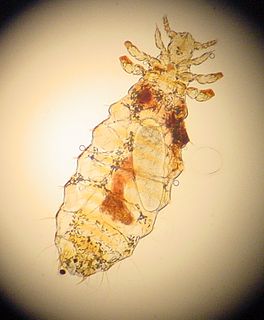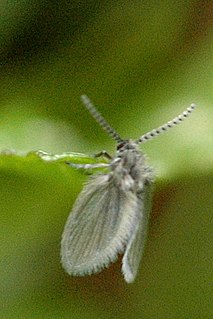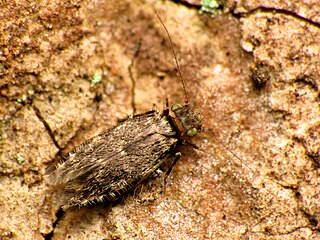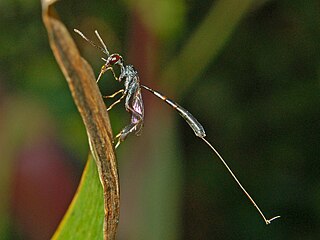
Sucking lice have around 500 species and represent the smaller of the two traditional superfamilies of lice. As opposed to the paraphyletic chewing lice, which are now divided among three suborders, the sucking lice are monophyletic.

Carpenter bees are species in the genus Xylocopa of the subfamily Xylocopinae. The genus includes some 500 bees in 31 subgenera. The common name "carpenter bee" derives from their nesting behavior; nearly all species burrow into hard plant material such as dead wood or bamboo. The main exceptions are species in the subgenus Proxylocopa; they dig nesting tunnels in suitable soil.

Psychodidae, called drain flies, sink flies, filter flies, sewer flies, or sewer gnats, is a family of true flies. Some genera have short, hairy bodies and wings giving them a "furry" moth-like appearance, hence one of their common names, moth flies. Members of the sub-family Phlebotominae which are hematophagous may be called sand flies in some countries, although this term is also used for other unrelated flies.

The Micropezidae are a moderate-sized family of acalyptrate muscoid flies in the insect order Diptera, comprising about 500 species in about 50 genera and five subfamilies worldwide,. They are most diverse in tropical and subtropical habitats, especially in the Neotropical Region.

The minute black scavenger flies or "dung midges", are a family, Scatopsidae, of nematoceran flies. Despite being distributed throughout the world, they form a small family with only around 250 described species in 27 genera, although many await description and doubtless even more await discovery. These are generally small, sometimes minute, dark flies, generally similar to black flies (Simuliidae), but usually lacking the humped thorax characteristic of that family.

Troctomorpha is one of the three major suborders of Psocodea (barklice, booklice, and parasitic lice), alongside Psocomorpha and Trogiomorpha. There are more than 30 families and 5,800 described species in Troctomorpha. The order includes parasitic lice, which are most closely related to the booklice family Liposcelididae.

The Pyrgotidae are an unusual family of flies (Diptera), one of only two families of Cyclorrhapha that lack ocelli. Most species are "picture-winged", as is typical among the Tephritoidea, but unlike other tephritoids, they are endoparasitoids; the females pursue scarab beetles in flight, laying an egg on the beetle's back under the elytra where the beetle cannot reach it. The egg hatches and the fly larva enters the body cavity of the beetle, feeding and eventually killing the host before pupating. In the United States, some species of Pyrgota and Sphecomyiella can be quite common in areas where their host beetles are abundant. Like their host beetles, these flies are primarily nocturnal, and are often attracted to artificial lights.

Alderflies are megalopteran insects of the family Sialidae. They are closely related to the dobsonflies and fishflies as well as to the prehistoric Euchauliodidae. All living alderflies – about 66 species all together – are part of the subfamily Sialinae, which contains between one and seven extant genera according to different scientists' views.

The Psychodinae are the nominate subfamily of moth flies (Psychodidae), also known as drain flies. Like most of their relatives, they are usually found in damp habitats; some occur in caves. The small larvae are aquatic or semi-terrestrial; the adults are winged and capable of flight. Psychodinae are found worldwide, including some subantarctic islands.

Lepidopsocidae are an insect family of bark lice belonging to the suborder Trogiomorpha. Colloquially, Lepidopsocidae are referred to as the Scaly-winged Barklice. There are more than 220 species described worldwide. Phylogenetic DNA analysis of relationships between families in Trogiomorpha propose that Lepidopsocidae is monophyletic, meaning that the taxa within all share a common ancestor. This is supported morphologically by the presence of scales and setae covering the body and forewings of Lepodopsocids. Sister families of Lepidoposcidae include Trogiidae and Psoquillidae.

Gasteruption is a genus of wasps belonging to the family Gasteruptiidae subfamily Gasteruptiinae.

Pedicinus is a genus of sucking louse, the only genus in the family Pedicinidae. Species belonging to this genus are found on Old World monkeys and apes of different kinds. Pedicinus, along with its sister genus Pthirus, are believed to have diverged from their common ancestor approximately 22.5-2.5 million years ago.

Hyptia is a genus of ensign wasps in the family Evaniidae. There are at least 50 described species in Hyptia. Most Hyptia can be differentiated from other genera by heavily reduced venation of the forewings, wherein only one closed cell is present.

Cerastipsocus is a genus of common barklice in the family Psocidae. There are more than 20 described species in Cerastipsocus.
Steleops is a genus of common barklice in the family Psocidae. There are more than 20 described species in Steleops.
Embidopsocus is a genus of booklice in the family Liposcelididae. There are more than 40 described species in Embidopsocus.
Evaniella is a genus of ensign wasps in the family Evaniidae. There are more than 70 described species in Evaniella.

Sciomyzinae is a subfamily of flies in the family Sciomyzidae.

Linognathidae is a family of lice in the order Psocodea. There are at least 3 genera and 70 described species in Linognathidae.

Polyplax is a genus of lice belonging to the family Polyplacidae.
















